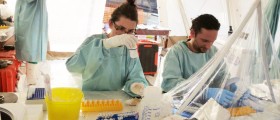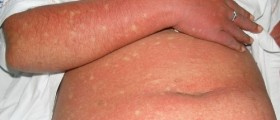Classification
To be classified as a communicable disease, an infection has to be present only in people affected by it and not those who are otherwise healthy and the healthy individuals who come into contact with the elements causing the infection have to fall ill as well.
For an abnormality to be considered an infection the adverse agents have to come into the body, live for long enough to multiply, and should be passed to other hosts easily.

Communicable diseases are illnesses that are caused by viruses, bacteria, parasites, and prions, and are easily transferable from person to person. Communicable diseases cause infections that in most cases produce various kinds of symptoms, while the adverse agents responsible for the infections also need a weakened immune system which will make a problem.
- There are six criteria that need to be met to diagnose a hepatitis infection. These criteria include an infection agent, in this case, the hepatitis virus, a reservoir, route of infection, transmission mode, route of entry, and a susceptible subject who becomes infected with the virus.
- There are four major patterns of HAV (Hep A) infections worldwide divided into areas of high, intermediate, low, or very low prevalence. Endemic areas of high prevalence include parts of Africa, Asia, and Latin America. Most infections in these areas occur in early childhood. Areas of low prevalence and very low prevalence include North America and Western Europe with few infections during childhood and majority of the population are susceptible throughout adulthood.
- In the United States, HAV is one of the most reported diseases among vaccine-preventable diseases. Over 30,000 cases were reported in 1997. An estimated 270,000 HAV infections are said to have occurred each year between 1980 and 1999. A total of 1390 cases of hepatitis A were reported from 50 states to the Centers for Disease Control and Prevention (CDC) in 2015.
- There was a 12.2% increase from reported cases of HAV in 2014. Of note, the overall incidence in 2015 was 0.4 cases per 100,000 population which was the same as in 2014 (CDC, 2017). Since 1996, the declining incidence in the United States is attributed to the widespread use of HAV vaccination for populations considered high-risk.
- An incidence of 1 case per 10,000 was notably the lowest recorded in 2007. States with routine vaccination for children also noticeably made the most noticeable difference. Overall, there has been a 95% decline in HAV in the United States since the vaccine for HAV became available in 1995.
The stronger the adverse element, or a pathogen, coupled with a weak immune system, the stronger the infection. As a result, pathogens are classified based on the severity of the destruction they cause for the organism.
Primary pathogens are very strong and will result in an infection in healthy individuals, while also affecting other animals, as well. The extent of the infection produced by a primary pathogen depends on both its strength and the strength of the person it’s affecting.
Another kind of pathogen are opportunistic pathogens, which otherwise live in the body without causing any problems, but when the opportunity presents itself is likely to cause an infection. Opportunistic pathogens can also come in contact with a person through various external means, such as through wound infections, blood transfusions, poisoning, and so on. In order for opportunistic pathogens to produce an infection, the person’s immune system has to be susceptible and unable to fight it off.
Communicable diseases can occur from time to time, have a regular presence in a population or a geographic area, be present in lots of people at once, or be spread globally.
Transmission
There are many ways in which the elements that cause communicable diseases are passed on from individual to individual and some include coming into contact with contaminated food, water, bodily fluids, or an infected person.
In any case, there has to be a source of infection, and identifying it helps to a great extent with dealing with an infection once it becomes a problem. There are those infections that are passed on very easily through minor physical contact, such as handshaking, sneezing, kissing, and so on, and there are instances in which the road to infection is well known, such as having sexual relations with an infected person.
In some instances, there are pathogens that survive on external objects, such as money, and coming into contact with them leads to an infection. There are various insects, such as flies or mosquitoes, which can transmit infectious agents from an animal or an object to a person.
Diagnosis
Many relatively common infectious diseases are diagnosed by the presentation of symptoms. The adverse agents are easily identifiable, the treatment relatively simple and the consequences minor or nonexistent. In many cases, identification of the pathogen is done only when it can help with the advancement of prevention or treatment.
There have been various kinds of advancements that lead to better diagnostics, such as the use of molecular diagnostics to identify the HIV virus in individuals who haven’t developed infections yet. As a result, clinicians and researchers are able to follow the virus and its development, while at the same time the person in question is aware that he or she is carrying HIV.
For the most part, the inspection of the symptoms coupled with the patient’s medical history and culture tests of pathogens usually make up the course of diagnosis. In some cases, various scans will be employed for identifying skeletal communicable illnesses.
Prevention
In order to prevent the spreading of an infection, it first has to be established what the pathogens are and where they are coming from. There are also other elements that have to be taken into consideration, such as the time it takes for the infection to be passed on, and how contagious it is in the first place.
For instance, there are many viruses that upon entering the system will kill the person relatively quickly, such as the Ebola virus, so there isn’t that much opportunity for the spreading. However, viruses such as HIV take a long time to develop into an infection, and there are many cases in which the virus is being spread without the person carrying it even being aware.
Some beneficial ways to stop the spreading of agents that cause communicable diseases include the introduction of programs such as needle exchange among the populations of intravenous drug users, vaccination of individuals who are susceptible to viral infection, and pest control.
In many cases, however, when it comes to the most common infections, washing hands regularly will decrease the spreading of infectious diseases.

















Your thoughts on this
Loading...